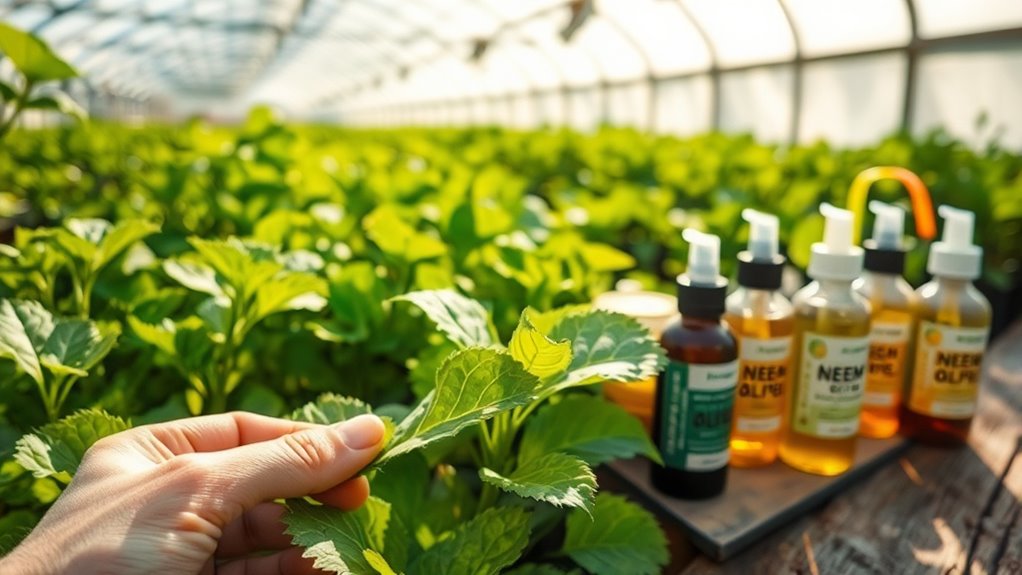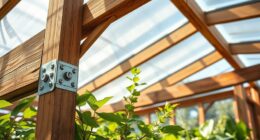To manage thrips in your greenhouse, start by maintaining cleanliness and removing debris where thrips might hide. Use sticky traps for monitoring and scout regularly for signs of infestation. Introduce beneficial insects like predatory mites and minute pirate bugs to control thrips populations. Keep an eye on environmental conditions, as humidity and temperature can influence their growth. By implementing an integrated pest management plan, you can stay ahead. Discover more effective strategies in the following sections.
Key Takeaways
- Regularly inspect plants using a 10X hand lens and sticky traps to detect thrips early and monitor their population.
- Implement sanitation practices by removing debris and weeds to eliminate thrips habitats in and around the greenhouse.
- Introduce beneficial insects like predatory mites and minute pirate bugs to naturally control thrips populations.
- Maintain optimal humidity and temperature conditions to support plant health and deter thrips infestations.
- Use biorational pesticides, such as insecticidal soaps, to manage thrips while minimizing harm to beneficial organisms.
Understanding Thrips Biology
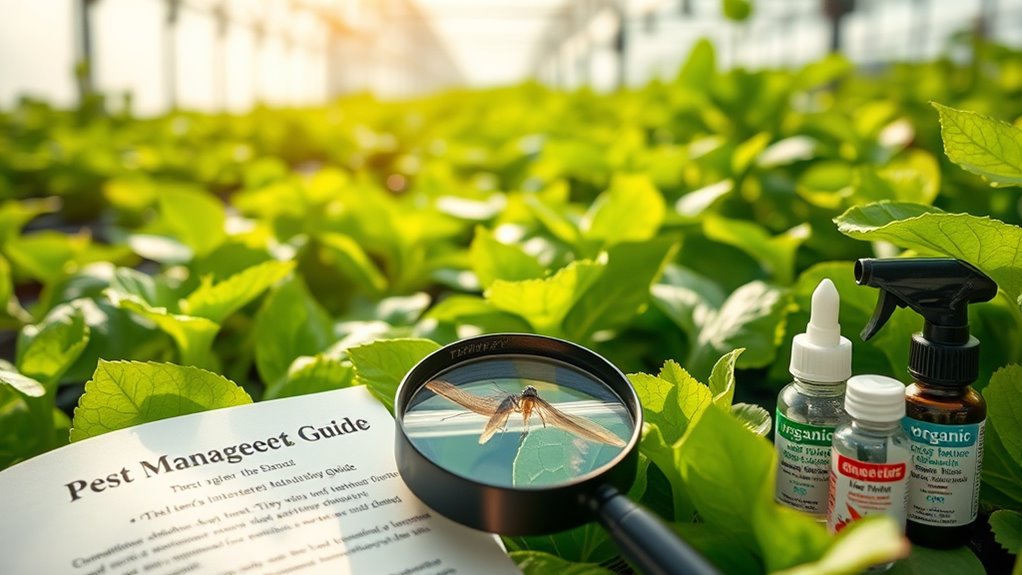
Understanding the biology of thrips is essential for effective management in your greenhouse. Thrips undergo a life cycle that includes egg, larval, prepupal, pupal, and adult stages, completing it in as little as 13 days under ideal conditions.
Effective greenhouse thrips management starts with understanding their rapid life cycle and feeding habits.
They lay eggs in plant tissues, and the larvae feed on plant sap, causing visible damage. Adult thrips, which can fly, are often found on the undersides of leaves.
They thrive in warm, humid environments and prefer to feed in groups, primarily during the late afternoon. Recognizing different species can be challenging since adult thrips vary in color and size.
Understanding these aspects helps you identify, monitor, and manage thrips effectively in your greenhouse.
Preventive Measures for Thrips Control

To effectively manage thrips in your greenhouse, implementing preventive measures is vital. Start with sanitation by regularly removing weeds and debris to eliminate thrips habitats.
Maintain healthy plant conditions by controlling humidity and temperature, which discourages their proliferation. Choose resistant plant varieties and guarantee proper irrigation to reduce plant stress. Avoid excessive nitrogen in fertilizers, as it can promote thrips populations.
Additionally, consider physical barriers like microscreening and maintaining screens to prevent entry. Keep doors closed and vents screened, and use blue sticky traps for early detection.
Balancing airflow with screening is essential for overall greenhouse health. By taking these steps, you can create an environment less conducive to thrips infestations, safeguarding your plants.
Monitoring and Detection Techniques
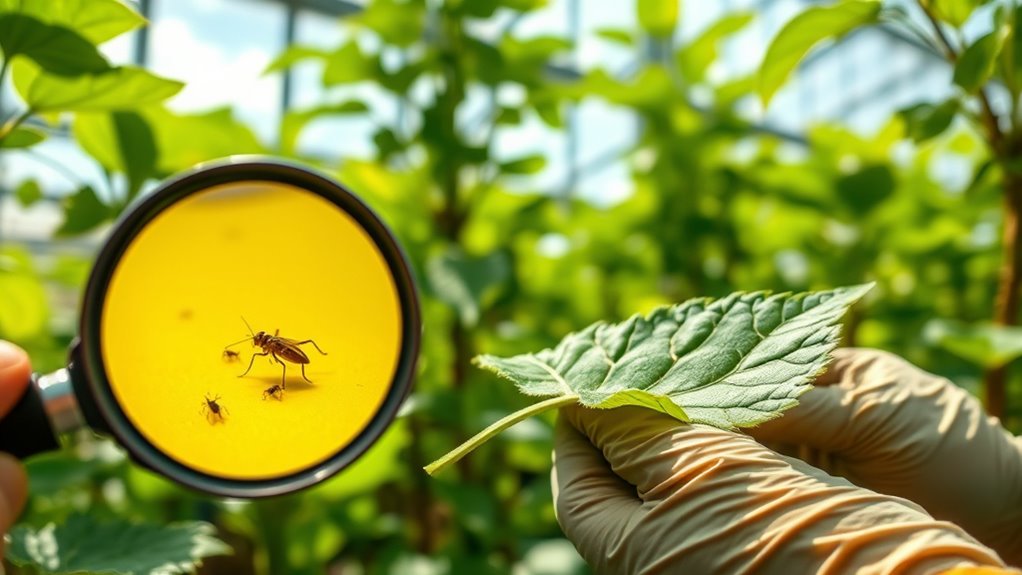
Effective management of thrips in your greenhouse requires vigilant monitoring and detection techniques.
Effective thrips management in greenhouses hinges on diligent monitoring and precise detection methods.
Start by using sticky traps, placing them just above your crop canopy. Hot-pink traps are particularly effective, but blue and yellow options work too. Position traps near doors, vents, and sensitive plants at a rate of one per 500 to 1,000 square feet.
Conduct regular visual inspections with a 10X hand lens to spot live thrips and their activity. The tapping method is also useful; gently tap flowers onto a white sheet to catch thrips.
Make sure to scout at least once a week, adjusting your frequency based on thrips activity. Collect data on populations to inform your control decisions and strategies.
Biological Control Methods
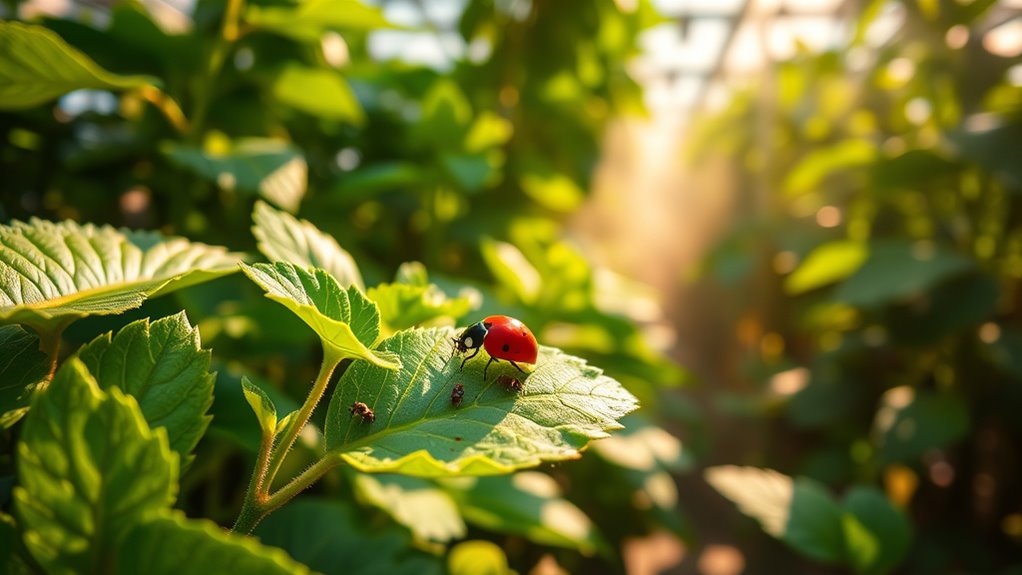
While managing thrips in your greenhouse, incorporating biological control methods can considerably enhance your pest management strategy.
You can use predatory mites like *Neoseiulus cucumeris* and *Amblyseius swirskii* to feed on thrips larvae, while minute pirate bugs, such as *Orius insidiosus*, control both adults and larvae.
Nematodes like *Steinernema feltiae* target pupae in the soil, and fungal pathogens like *Beauveria bassiana* infect thrips with spores.
Apply these agents directly to foliage or soil, using methods like slow-release sachets or bran mixtures.
Maintaining high humidity and ideal temperatures is essential for effectiveness.
Implementing these biological agents early and regularly can help manage thrips populations sustainably, reducing reliance on chemical pesticides over time.
Chemical Control Strategies
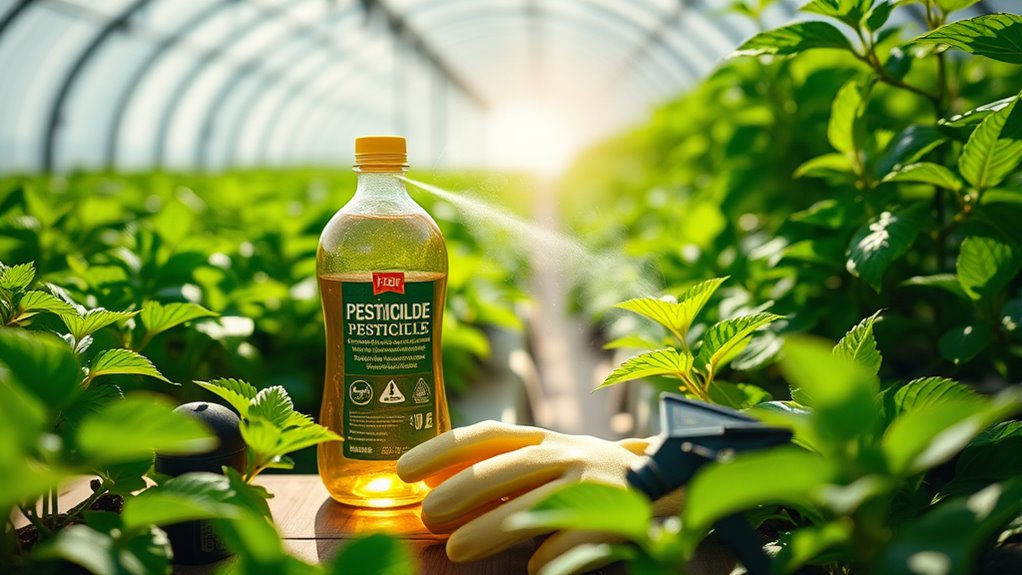
Managing thrips in your greenhouse often requires the use of chemical control strategies, especially when biological methods alone aren't enough. Thrips are resistant to most pesticides, making effective control challenging.
Their feeding habits can complicate insecticide applications, as they often hide in flower heads and developing leaves. You might consider using acephate or abamectin, both known for their effectiveness, but be cautious—many chemicals harm beneficial insects and pollinators.
Always follow label instructions to avoid environmental contamination. Rotate chemical classes every two to three weeks to prevent resistance, and aim for thorough spray coverage with smaller droplet sizes.
Regularly monitor for resistance signs to adjust your strategies effectively and responsibly.
Integrated Pest Management (IPM) Approach
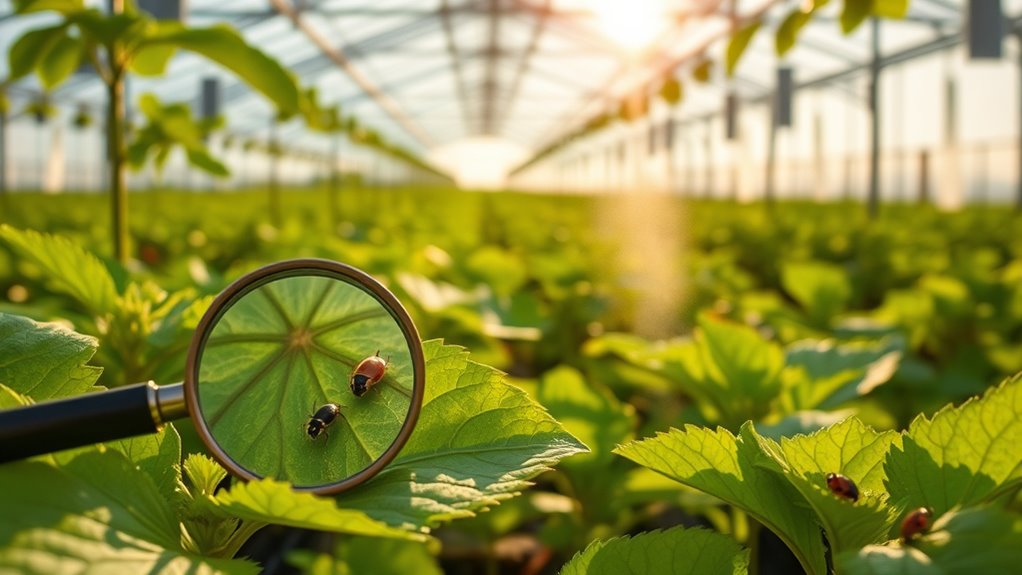
An Integrated Pest Management (IPM) approach combines various strategies to keep thrips and other pests under control in your greenhouse.
Start by conducting daily inspections of indicator plants and using yellow sticky traps to monitor thrips activity effectively. Place traps in a grid pattern above the plant canopy for ideal results.
Maintain cleanliness to minimize thrips hiding spots and introduce beneficial insects like predatory mites and minute pirate bugs for biological control.
Utilize biorational pesticides, such as horticultural oils and insecticidal soaps, to manage populations without harming beneficial species.
Finally, keep detailed records of pest sightings and treatments, allowing you to adapt your IPM strategies as pest conditions change, ensuring long-term success in thrips management.
Environmental Factors Influencing Thrips
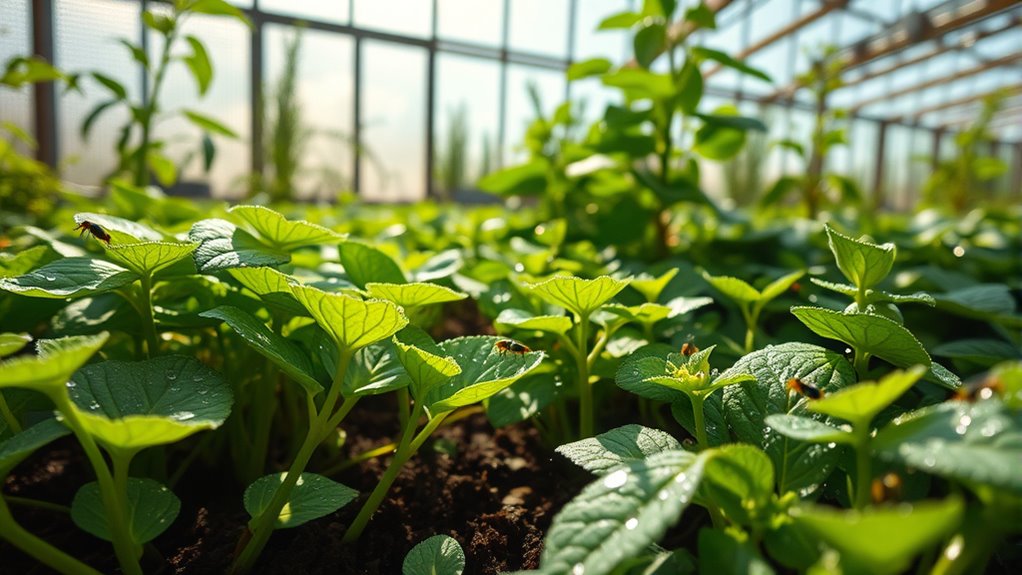
Understanding how environmental factors influence thrips is essential for effective management in your greenhouse.
Temperature plays a vital role, as thrips thrive in warm conditions, leading to rapid population growth. Higher humidity enhances their survival and reproduction, which can greatly affect population dynamics.
Additionally, microclimates within your greenhouse can create ideal conditions for thrips development. Climate change, with its shifting temperature and humidity patterns, may alter thrips distribution and abundance over time.
Weather patterns, such as wind, can also facilitate their dispersal. By recognizing these factors, you can adjust your greenhouse environment to create less favorable conditions for thrips, helping to maintain healthier plants and more productive growing conditions.
Importance of Regular Scouting and Inspection
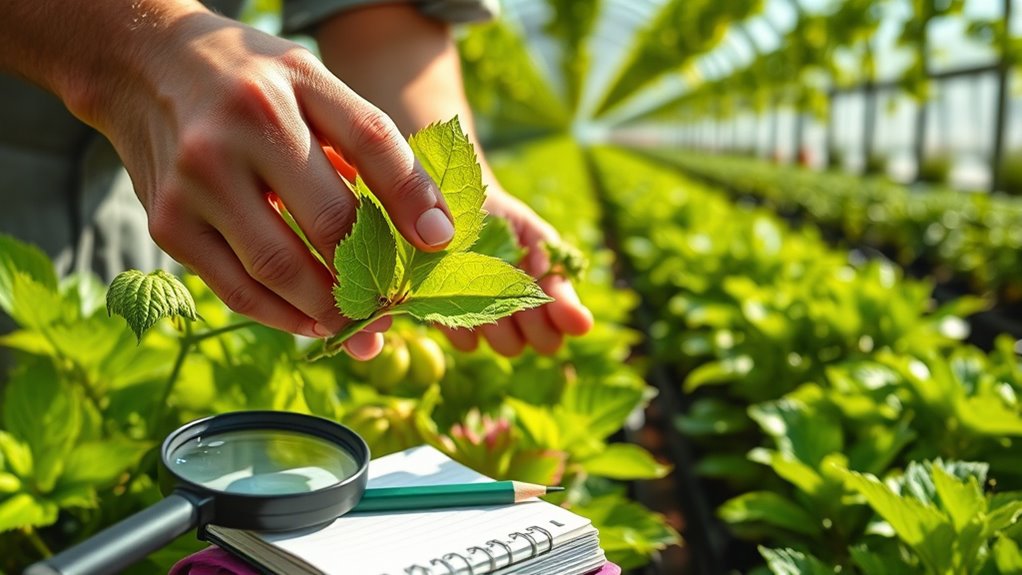
Regular scouting and inspection are essential for keeping thrips populations in check and ensuring plant health.
By tapping plants over white paper or exhaling carbon dioxide on flowers, you can effectively detect thrips.
Using sticky traps—especially blue ones—helps monitor populations and can guide your pest management decisions.
Aim for weekly inspections and check traps frequently, as early detection is vital to prevent significant damage.
Utilize indicator plants like petunias for straightforward monitoring.
Regular inspections not only reduce chemical use but also improve plant quality and save costs by preventing infestations.
Incorporating systematic approaches and thorough checks will enhance your pest management strategy and maintain a healthy greenhouse environment.
Frequently Asked Questions
What Are the Signs of a Thrips Infestation on Plants?
When you notice signs of a thrips infestation, look for visible damage like bronzed or curled leaves.
You might see small black fecal spots on your plants, along with discolored areas showing silvery streaks.
Buds may fail to open, becoming deformed, and over time, your plants could decline, leading to leaf loss.
Keep a close eye on your plants to catch these signs early and take action before the infestation worsens.
How Quickly Can Thrips Populations Grow in a Greenhouse?
In a greenhouse, thriving plants can quickly turn into a battleground as thrips populations explode.
Under ideal conditions, these pests can complete their life cycle in just two weeks, leading to up to eight generations in a year.
Imagine watching a few become hundreds in mere months. With females laying 150 to 300 eggs, it's crucial to stay vigilant.
Your careful monitoring can make all the difference in keeping them at bay.
Can Thrips Affect Indoor Houseplants as Well?
Yes, thrips can definitely affect your indoor houseplants.
If you notice yellow or silvery streaks on the leaves, it's likely a sign of an infestation. These pests feed on plant sap, causing damage that can distort growth.
To protect your plants, regularly inspect them and isolate any new additions for a few weeks.
Using sticky traps can help you monitor for thrips and catch them early before they cause significant harm.
What Plants Are Most Susceptible to Thrips Damage?
"You reap what you sow," especially when it comes to plant care.
If you're growing azaleas, roses, or ferns, watch out—these plants are particularly susceptible to thrips damage.
Carnations and chrysanthemums in your greenhouse can also become targets.
Thrips thrive in dry, shady environments, so keep your plants healthy and well-watered.
Regular monitoring will help you catch any infestations early, ensuring your garden remains vibrant and thriving.
How Do Weather Changes Impact Thrips Activity?
Weather changes considerably impact thrips activity.
When temperatures rise between 68°F and 90°F, thrips thrive, completing their life cycle quickly. Higher humidity can suppress their numbers, while increased sunlight boosts their activity.
You'll notice that wind speeds affect their dispersal but less so their population.
As climate change alters temperature and precipitation patterns, thrips may adapt and migrate, making it essential for you to stay informed about these environmental shifts.
Conclusion
In summary, managing thrips in your greenhouse is essential for healthy plants and successful yields. Did you know that a single female thrip can lay up to 300 eggs in her lifetime? That's why implementing preventive measures and regular monitoring is vital. By combining biological control methods with chemical strategies, you can create a robust integrated pest management plan. Stay vigilant, and don't underestimate the impact of these tiny pests—they can wreak havoc if left unchecked!
